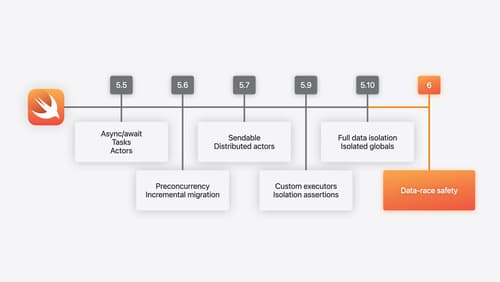What is Concurency
Asked on 2024-08-08
1 search
Concurrency in the context of Swift, as discussed in various WWDC sessions, refers to the ability to execute multiple tasks simultaneously, which can significantly improve the performance and responsiveness of applications. Here are some key points about concurrency from the provided context:
-
Data-Race Safety: Concurrency in Swift aims to prevent data races, which occur when multiple threads access shared data simultaneously and at least one thread modifies it. Data races can lead to unpredictable behavior and crashes. Swift 6 introduces complete data-race safety by default, turning potential data race issues into compile-time errors (What’s new in Swift).
-
Concurrency Architecture: Swift's concurrency model includes actors, which are used to protect mutable state and ensure that only one task can access the state at a time. This helps in organizing the concurrency architecture clearly and avoiding data races (Migrate your app to Swift 6).
-
Async/Await and Actors: Swift uses the
async/awaitsyntax to handle asynchronous tasks, making the code easier to read and maintain. Actors are used to encapsulate state and ensure that only one task can access the state at a time, providing a clear and safe concurrency model (A Swift Tour: Explore Swift’s features and design). -
Concurrency Checking: Swift 6 introduces strict concurrency checking, which helps developers identify and fix concurrency issues during development. This includes warnings and errors from the Swift compiler about potential concurrency issues (Migrate your app to Swift 6).
-
Main Actor: The main actor is used to ensure that certain tasks, especially those related to UI updates, are executed on the main thread. This is crucial for maintaining a responsive user interface (Migrate your app to Swift 6).
For a more detailed exploration of concurrency in Swift, you can refer to the session A Swift Tour: Explore Swift’s features and design.

Migrate your app to Swift 6
Experience Swift 6 migration in action as we update an existing sample app. Learn how to migrate incrementally, module by module, and how the compiler helps you identify code that’s at risk of data races. Discover different techniques for ensuring clear isolation boundaries and eliminating concurrent access to shared mutable state.

A Swift Tour: Explore Swift’s features and design
Learn the essential features and design philosophy of the Swift programming language. We’ll explore how to model data, handle errors, use protocols, write concurrent code, and more while building up a Swift package that has a library, an HTTP server, and a command line client. Whether you’re just beginning your Swift journey or have been with us from the start, this talk will help you get the most out of the language.

What’s new in Swift
Join us for an update on Swift. We’ll briefly go through a history of Swift over the past decade, and show you how the community has grown through workgroups, expanded the package ecosystem, and increased platform support. We’ll introduce you to a new language mode that achieves data-race safety by default, and a language subset that lets you run Swift on highly constrained systems. We’ll also explore some language updates including noncopyable types, typed throws, and improved C++ interoperability.
